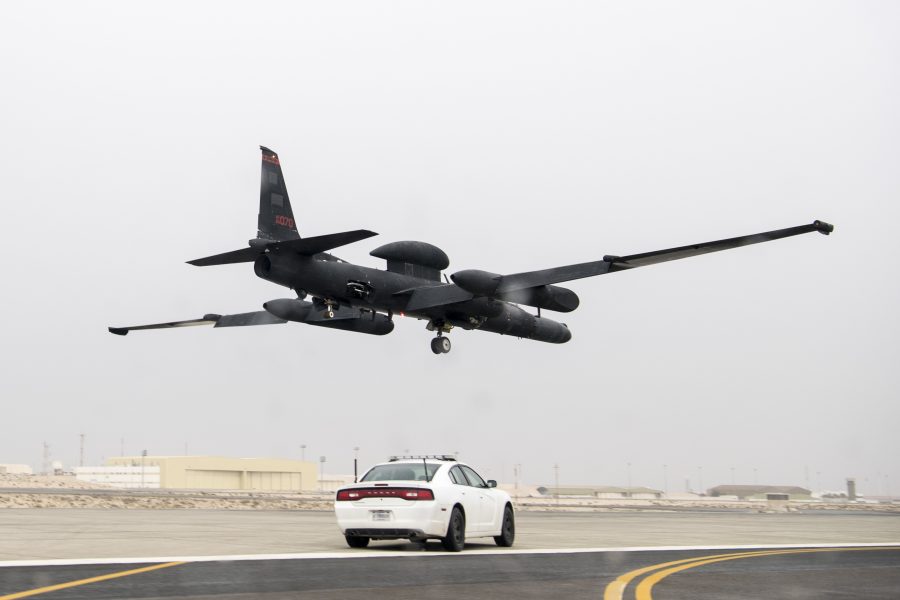U-2S is the Air Force’s only manned, strategic, high-altitude, long-endurance ISR platform and is capable of SIGINT, IMINT, and MASINT collection. The aircraft’s modular payload systems allow it to carry a wide variety of advanced optical, multispectral, EO/IR, SAR, SIGINT, and other payloads simultaneously. Its open system architecture also permits rapid fielding of new sensors to counter emerging threats and requirements.
The original U-2A first flew on Aug. 4, 1955. The type was further developed into the larger, more capable U-2R which first took flight on Aug. 28, 1967, and was delivered between 1967 and 1968.  Current U-2s date to the 1980s when U-2R production was reopened under the designation TR-1 (later returned to U-2R designation in 1992). The TR-1A first flew on Aug. 1, 1981, and was reengined and modernized starting in 1994, emerging as the U-2S.
Current U-2s date to the 1980s when U-2R production was reopened under the designation TR-1 (later returned to U-2R designation in 1992). The TR-1A first flew on Aug. 1, 1981, and was reengined and modernized starting in 1994, emerging as the U-2S.
Current Block 20 U-2S feature glass cockpits, digital autopilot, modernized EW systems, and updated data links. Its major sensors are the ASARS-2A SAR, modernized SYERS-2C multispectral EO/IR imagery system, and enhanced Airborne Signals Intelligence Payload (ASIP). The aircraft is also capable of mounting the legacy optical bar camera for broad-area synoptic imagery, though operations from Beale concluded in 2022.
Modification and upgrades are focused on sustaining U-2 capability through its currently planned retirement, while meeting current and emerging requirements. Current development and mods support Block 20.1 upgrades. Major efforts include ASARS-2B/C integration, avionics and navigation refresh, (Link-16/IFDL, MADL) modernization, next-generation SIGINT, and quick-response capabilities to meet emergent ISR requirements. ASARS-2B/C significantly improves the U-2’s high-altitude, deep-look radar ground mapping, moving target, and maritime capabilities and moves to an open, easily upgradable architecture. ASARS-2B/C continued flight testing through expected IOC in 2024. The 2B/C will replace the current 2A and its open architecture makes it transferable to future platforms.
A U-2 upgraded to Avionics Technical Refresh (ATR) standards flew for the first time in September 2023, adding open-architecture systems, enhanced C2 networking, and pilot workload management features. Development and modification efforts include ATR Phase 2, SIGINT and IR sensor technical refresh, stellar navigation for GPS-denied operations, SIGINT modernization, quick-change modular mission systems, unmanned-system interoperability, and a helmet and pressure suit refresh. The program continues to prioritize experimental sensors, systems, and software to meet emerging threats, and development of networked, next-generation BM/C2.
Two U-2s notably intercepted and photographed a Chinese ISR balloon over the central U.S. on Feb. 3, 2023, marking the two-seat TU-2S’s first operational use.
ACC retired the first TU-2S and three U-2S aircraft in early 2024 with plans to retire the entire fleet by 2026.
U-2S Dragon Lady Technical Data
Contractors: Lockheed Martin, Northrop Grumman (ASIP); Raytheon (ASARS); UTC Aerospace (SYERS/Optical Bar Camera).
First Flight: October 1994 (U-2S).
Delivered: September 1981-October 1989 (TR-1/U-2R).
IOC: Circa 1981 (U-2R).
Production: 35 (T/U-2S).
Inventory: 27 (U-2); four (TU-2).
Operator: ACC.
Aircraft Location: Beale AFB, Calif.; permanent forward operating locations worldwide.
Active Variants: •U-2S. Current variant of the U-2/TR-1. •TU-2S. A two-seat trainer aircraft originally designated U-2ST.
Dimensions: Span 105 ft, length 63 ft, height 16 ft.
Weight: Max T-O 40,000 lb.
Power Plant: GE Aviation F118-GE-101A turbofan, 17,000 lb thrust.
Performance: Speed 410 mph, range 7,000+ miles.
Ceiling: Above 70,000 ft.
Accommodation: Pilot (U-2S); two pilots (TU-2S) on RQ201 zero/zero ejection seats.


